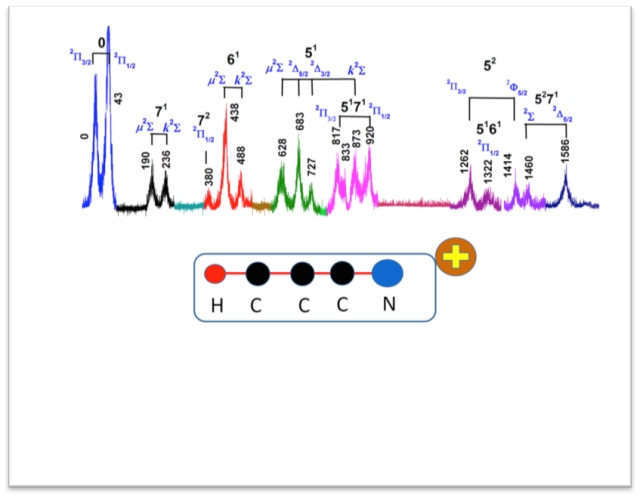Aug 6 2015
Researchers at Beijing’s Tsinghua University have obtained a highly detailed list of cyanoacetylene cation’s quantum energy levels using zero-kinetic energy (ZEKE) photoelectron spectroscopy.
 High resolution photoelectron spectrum of HCCCN. Credit-YMO/Tsinghua
High resolution photoelectron spectrum of HCCCN. Credit-YMO/Tsinghua
Cyanoacetylene cation is a five-atom linear molecule that demonstrates electronic and nuclear coupling effects. It is found in Titan’s (Saturn's largest moon) atmosphere and in interstellar clouds.
It is commonly assumed that the vibrational motion of the nucleus does not affect the electronic states of an atom when molecular motion is being described. This is considered to be due to the considerable disparity between particles and electrons in the nucleus, and this is also called the Born-Oppenheimer approximation.
This approximation cannot sufficiently describe the energetic state changes for photo-induced processes where cyanoacetylene is involved. The research team intends to gain a better understanding of these processes by analyzing cyanoacetylene’s energy structures and the energy structures of other similar organic molecules.
"[It] is an ideal tool to study the energy structure of the cation," said Yuxiang Mo, a physics professor at Tsinghua University in Beijing, and primary investigator on the project. "At the present, there is no other experimental tool that can accomplish this task."
Cyanoacetylene is made up of one hydrogen atom, one nitrogen atom, and three carbon atoms. It is considered to be a composed of linear, symmetric molecules having degenerate electronic states, and in these types of materials exceptions to the Born-Oppenheimer approximation take place.
In these cases, electronic and nuclear motions are vibronically coupled, and hence when a change occurs in one it will also affect the other. This phenomenon is considered to be the Renner-Teller effect.
In this experiment, the team pumped the cyanoacetylene molecules to the Rydberg states that are highly electronically excited states, by utilizing a pulsed, nanosecond, tunable vacuum ultraviolet laser.
In order to enable detection of the ions, an extremely small, pulsed electric field was then used to ionize the ions. Then, using the four-wave technique, a vacuum ultraviolet laser that was composed of two laser beams was concentrated on to a pulsed xenon gas jet. The ions’ energy levels were then obtained using standard spectroscopy, by scanning the vacuum ultraviolet laser’s frequency.
ZEKE photoelectron spectroscopy is effective for measuring the vibrational energy of the cations. This technique has enabled the team to obtain a complete high-resolution readout of the cations’ energy levels that extend from their vibrational ground state to their excited states. These excited states are of higher magnitudes of frequency, and help advance understanding about the coupled vibrations that take place in the Renner-Teller effect.
The team obtained the cyanoacetylene cation’s theoretical vibronic energy levels from a diabatic model, and these were found to be in agreement with the energy levels of the ions. In a quantum system, the diabatic model is used to explain the nuclear and electron coupling effects.
For chloromethane, fluoromethane and monochloroacetylene cations, the researchers acquired a list of spin-vibronic energy levels. These cations are linear or highly symmetric molecules that demonstrate strong nuclear and electron coupling effects.
"From these results, it seems that now we understand the main physics of the vibronic coupling for these benchmark molecules," Mo said.
Going forward, the researchers intend to measure the vibronic energy levels in more general situations, which includes situations such as electronic potential energy surfaces crossing accidentally.
The study paper entitled, "The Renner-Teller effect in HCCCN+(X2Π) studied by zero-kinetic energy photoelectron spectroscopy and theoretical calculations," has been published in the Journal of Chemical Physics from AIP Publishing. The authors of the study are Yuxiang Mo, Zuyang Dai, Jia Wang and Wei Sun.